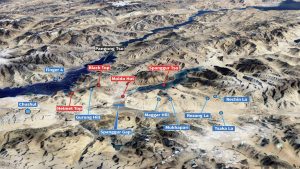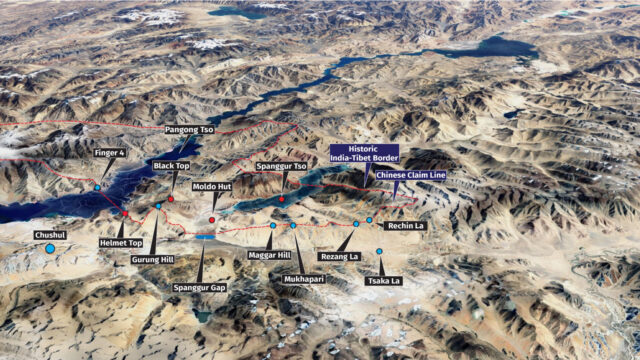NEW DELHI: Three years ago around this time, then Northern Army Commander Lt Gen. YK Joshi ordered what has now come to be known as the Kailash Range operation to turn the tables on the Chinese PLA determined to change the status quo on the Line of Actual Control (LAC) in Ladakh.
What you will read in the following paragraphs are details of what triggered the Indian response, how the Chinese reacted and how the counter-strike led to more serious negotiations since then.
But first, let’s recall what Lt Gen. Joshi said on record in an interview to me in Leh in February 2021 even as the first set of disengagement was in progress. (https://www.youtube.com/watch?v=_86vzHo9eOw&t=70s)
I asked him, in the course of the interview, did your action on August 29-30 give us an equal footing in the negotiations?
His answer: “Absolutely. That action finally turned the tables on the PLA and got them back to the negotiating table. Before August 29-30, we have already had five Corps Commander-level meetings. We were on the back foot. We had occupied certain areas of the north bank but Chinese were in some dominating locations. But post August 29-30 when we occupied the Rezang La and Rechin La complex, the most dominating features looking onto China’s Moldo garrison across the other side. We occupied the south bank and higher heights of Finger-4 dominating all the locations that the PLA had occupied. This action brought China back to the negotiating table. Our operations were well planned and well thought out and executed in a manner to totally surprise the PLA. They never expected that we’ll undertake such action. The credit goes to the soldiers on the ground and the zonal leaders who had planned, rehearsed. Since June 15 when the Galwan incident happened, we were preparing and, finally, we executed this to surprise our enemy.”
The operation which started late in the evening of August 29, 2020 was necessitated by intelligence reports and ground observation by troops located in forward positions of the Chushul bowl that alerted Indian military commanders about Chinese troops moving up the hills from their side to a couple of dominating features called Black Top and Helmet Top. The Chinese were clearly trying to pre-empt any possible Indian occupation of the heights along the Pangong and Kailash Range of mountains. Sensing the Chinese intentions, Lt Gen Joshi ordered troops from the nearest brigade stationed in the Chushul bowl to climb the heights but the Chinese beat the Indians to the top of Helmet top and Black top features (see map). This was on the intervening night between August 29 and 30.

So even as Indian troops faced off the Chinese on the slopes of these two features, Gen. Joshi realised it had the potential of developing into another stalemate. He needed to break the deadlock and put the Chinese under pressure somewhere. As Northern Army Commander, he had, in consultation with his top commanders—which included his own HQ Staff, 14 and 17 Corps Commanders, Lt Gen. Harinder Singh and Lt Gen. Savneet Singh, respectively—chalked several options or as they say in military parlance QPQ or quid pro quo (counter-strike) action.
As August 30 dawned, Lt Gen. Joshi realised that he had very little time as the Chinese, he suspected, may try to occupy the other heights in the vicinity putting the Indian positions at a severe disadvantage.
It was a Sunday morning and the Northern Army Commander thought he would quickly get through to Army Chief Gen. MM Naravane in Delhi and get his permission to go ahead with his planned action but to his surprise the Chief of Army Staff was attending a high-level meeting.
However, using his earlier experience of working in the Army HQ, Gen. Joshi found a way to reach the Army Chief. As Gen. Joshi’s request reached the Army Chief, he gave immediate clearance. The Army Chief apparently concurred with Gen. Joshi’s plan and gave him the go-ahead.
The Kailash Range QPQ was thus greenlighted.
Troops from brigades positioned near the Rezang La War memorial and all along the Kailash Range were rushed onto the Mukhpari, Rezang La and Rechin La peaks in broad daylight. This was the first time in 58 years (after the 1962 war) that troops had stationed themselves along the Kailash Range. Now, the Indian Army could look directly into the Moldo Garrison at the bottom of the Kailash Range on the other side. The Chinese were shocked. They never expected the Indian side to go beyond the standard drill. Gradually, India built up the strength and logistics support for the troops who had taken control of the ridgeline as Lt Gen. Savneet Singh (Retd), then the Commander of the 17 Mountain Strike Corps, told me in this interview (https://www.youtube.com/watch?v=rGyArBUU9ho). On the night of August 30, there was more tension, excitement and anticipation about a possible armed confrontation with the Chinese as the PLA too started moving troops uphill, backed by substantial armour strength.
Meanwhile, Gen. Joshi had also moved elements of an independent armoured brigade onto the ridgeline. By the afternoon of August 31, both sides had consolidated their presence resulting in an unprecedented situation where tank turrets were face to face, just 50 metres apart at some places. Another stalemate appeared to be in the offing.
However, the Northern Command had another surprise in store for the Chinese on the north bank of Pangong Tso. On August 31, troops under 39 Division (14 Corps elements) undertook a daring manoeuvre to go up the higher reaches of the Finger 4 ridgeline and managed to reach behind the PLA troops who had ensconced themselves on the slopes of Finger 4 since mid-May. Now, the Chinese were well and truly checkmated. They were outsmarted on the Kailash Range and had lost the advantage of sitting on the slopes of Finger 4 since the Indian troops had gone above and behind them by undertaking an unthinkable operation.
Looking back, those three days can be considered as a major turning point in the current round of India-China tension along the LAC. The Indian Army had turned the tables on the Chinese. The PLA commanders started taking the Corps Commanders level talks more seriously. Yet, it took nearly six more months to achieve the first set of disengagement on the north and south banks of Pangong Tso.
Questions have been raised on why the Indian side did not use the advantage that the Kailash range operations had given to get full disengagement including the friction points at Depsang and Demchok, Lt Gen. Joshi had a clear reasoning in that February 2021 interview. He said: “Rezang La is a dominating feature on the Kailash ranges which we had occupied. But it has been done purposely to push the negotiations to disengagement and that is what happened. It is not that the advantage is in perpetuity. We can’t equate the occupation of Rezang La, Rechin La and try to resolve the boundary issue with this.” What he essentially meant was the limited objective of the Kailash Range operation was to get the eyeball-to-eyeball situation on the north and south banks of Pangong Tso resolved. Rest of the friction points, in his view, could be discussed and solutions found subsequently.
Whatever be the final outcome in the current round of standoff in Ladakh, the Kailash Range operation has been registered as a milestone in the recent history of India-China tension.
Related Links
Nitin A. Gokhale is a media entrepreneur, one of South Asia's leading strategic affairs analyst and author of over a dozen books so far on military history, insurgencies and wars.
Starting his career in journalism in 1983, he has since led teams of journalists across media platforms.
A specialist in conflict coverage, Gokhale has covered the insurgencies in India’s North-East, the 1999 Kargil conflict and Sri Lanka’s Eelam War IV between 2006-2009.
Gokhale now travels across the globe to speak at seminars and conferences, and lecture at India’s premier defence colleges. He has founded three niche portals, Bharatshakti.in, stratnewsglobal.com and Interstellar.news.





